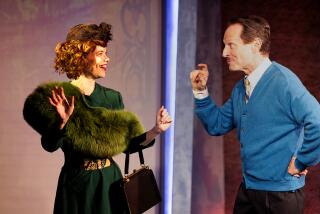THEATER REVIEW : ‘Triangle’s’ Points Are Blurred by Writing
- Share via
In the Nazi camps, homosexuals were forced to wear pink triangular patches. Win Wells’ “The Pink Triangle,” at Celebration Theatre, presents the fictionalized stories of a few of these pink-marked prisoners as a way of paying tribute to their real-life counterparts.
The tales are inherently compelling. But the points of this “Triangle” were ultimately softened by the playwright and by Robert Schrock’s staging.
The play is structured around the separate recollections of four survivors as they prepare for a 1978 banquet in New York honoring gay Holocaust victims. Two different actors play each survivor--one in 1978 and one in flashback scenes from the Nazi era.
Ernst was a student living with his lover when they were imprisoned. Ritzi was a female impersonator. Hinkelman was a valet to Adolf Hitler. Blossom was a 15-year-old American Jew who was visiting relatives in Poland.
For Ernst, the Nazi liberation wasn’t enough. The post-war Germans also imprisoned him for being gay. He became blind while staging a hunger strike in his post-war prison. This is the most unusual wrinkle in Wells’ exposition, but he tossed it away near the beginning of the play and then dropped it. None of the other victims suffers a similar double jeopardy.
This is typical. While Wells skillfully depicted the agonies endured by these men, he cut short his intellectual analysis of their plight. Why did the Nazis find homosexuals so threatening? How much of their persecution was due to Nazi doctrine and how much to a wider homophobia?
Don’t ask, don’t tell. The beastliness of the Nazi policy is simply taken for granted.
From his 1978 perspective, the character of Blossom fingers then-current gay-baiters John Briggs and Anita Bryant--names that today seem awfully dusty, if they’re recognized at all--in addition to the Nazis. And Schrock attempts to inject more contemporary resonance and insight into the play by mounting some of Robbie Conal’s images of recent U.S. figures (Reagan, Bush, J. Edgar Hoover) on the walls, right up there with one of Hitler. But whatever you may think of this analogy in general, it’s specious and strained here, like a form of visual name-calling.
Yet Schrock’s attitude toward the pictorial depiction of the camp days was too cautious. “We’ve tried to accomplish detailed realism . . . but we hope you will overlook such things as unshaved heads and other anatomical inconsistencies that are not true to the period,” he wrote in the program. We wouldn’t want to spoil an actor’s commercial audition, would we?
On one level, it’s OK. But the fact remains that the horror would be more horrifying if the victims looked more gaunt. Most of these inmates look as if they could be posing for a gay magazine. The nudity in the play might as easily titillate as repulse.
Though most of the younger characters are blandly written and performed, the older actors (Neil Elliott, Richard Ryder, George Shannon, Sean Moran) create much stronger characterizations. Shannon has an especially commanding presence as the former valet turned history professor; too bad Wells undercut his efforts with a soppy and unconvincing subplot about his attempt to enlighten one of his students, a straight jock (Robert Kerbeck).
* “The Pink Triangle,” Celebration Theatre, 7051-B Santa Monica Blvd., Hollywood. Thursdays-Saturdays, 8 p.m.; Sundays, 7 p.m. Ends Oct. 24. $15-$20. (213) 660-8587. Running time: 2 hours.
More to Read
The biggest entertainment stories
Get our big stories about Hollywood, film, television, music, arts, culture and more right in your inbox as soon as they publish.
You may occasionally receive promotional content from the Los Angeles Times.










